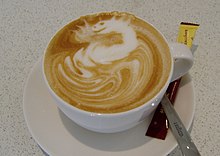Milk foam
Milk foam is used for coffee beverages , also to represent milk art as a decor. It is created by frothing milk , whereby its proteins and fats form structures that enclose air bubbles. A widespread assumption that milk foam should be as firm as possible is probably due to the comparison with the consistency of whipped cream .
Emergence

Milk is mixed with air when preparing milk foam for various coffee- based drinks , especially espresso- based drinks such as latte macchiato or cappuccino . The pore size of the foam depends not only on the fat content and the temperature of the milk but also on the duration of the preparation. By controlling these parameters, one varies the chemical equilibrium in the emulsion. There are various devices for making milk foam, in addition to electrical and mechanical milk frothers, there are two different systems for fully automatic coffee machines , pannarello and cappuccinatore . Espresso machines usually have a steam nozzle for frothing milk.
A low surface tension is required for foam formation. Milk is an emulsion made from fat and water that is stabilized by emulsifying lecithins . Animal emulsifiers work in the temperature spectrum of the body temperature of the producers. Soy lecithins have a broader spectrum of activity. The emulsifiers keep the proteins and fat in the milk in the emulsion. In raw milk, many fat droplets are so large that some of the fat, despite the emulsifiers, coalesces and settles on the surface as cream. Therefore, milk is homogenized again in the dairies .
When the milk is heated, the proteins, which are held in the suspension by the emulsifiers , coagulate and a skin forms. This means that more surfactants are available for each fat content, because the proteins are destroyed by clumping above 40 ° C, and stable foam can form.
In the case of very cold milk, the solidification temperature of the undissolved fats is close to that and there is an excess of emulsifiers that bind the proteins.
Used milk
The protein it contains is responsible for the formation of the milk foam, with the fat content of the milk playing a role. In addition, homogenized milk improves the result. The fat content of the milk should be at least 1.5%. A fat content higher than 3.5% favors the development and stability of the foam and leads to a creamier consistency overall. In plant-based milk, increased amounts of yeast and soy promote the foaming and buoyancy. Rice-heavy milk, on the other hand, is sweeter and generally doesn't carry the espresso. However, it can be foamed normally.
When frothing with a thermal process, you should start with milk that is as cold as possible and the temperature of the foam should not exceed about 60 ° C during the process. If the milk is too hot, the proteins coagulate.
Web links
- Kaffeewiki.de: frothing milk with the steam nozzle
- green-cup-coffee.de: Make milk foam yourself - instructions with download option
literature
- Alfred Töpel: chemistry and physics of milk. Behrs Verlag 2004 ISBN 3-89947-131-8 ( Google Books )
Individual evidence
- ↑ “Investigations on the characterization of the macro and microstructure of milk foams” Katja Borcherding, University of Kiel Dissertation on milk foam.
